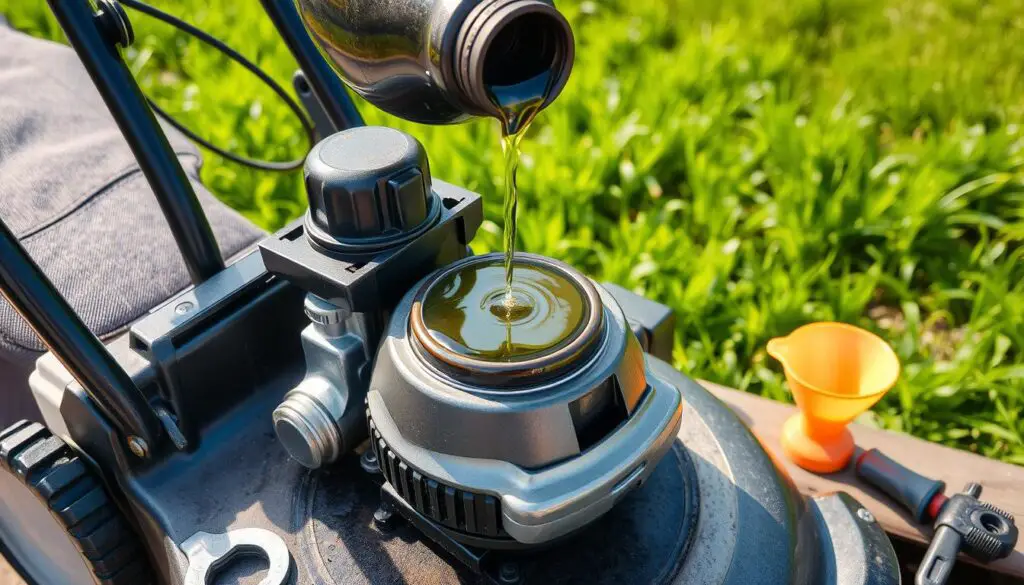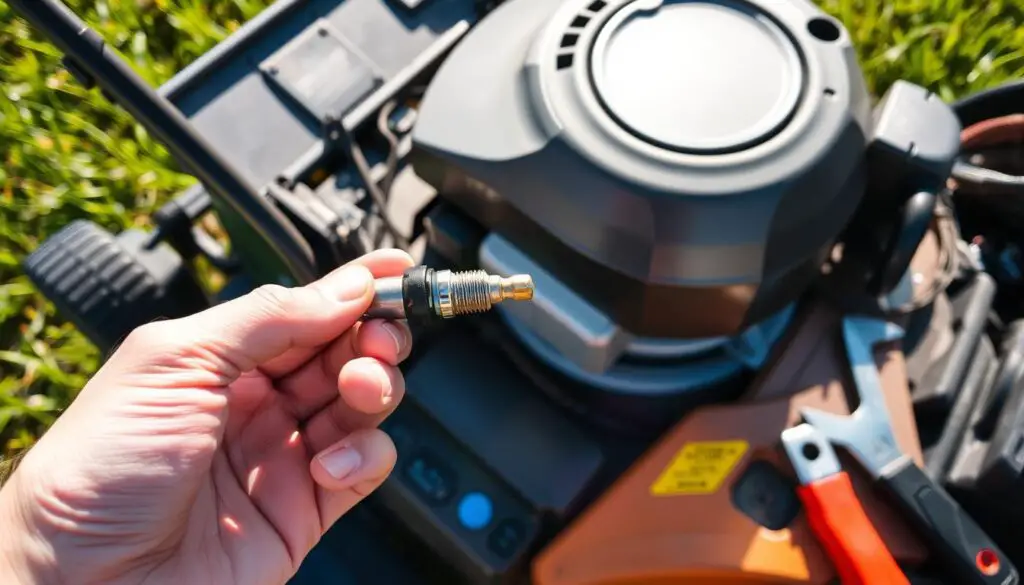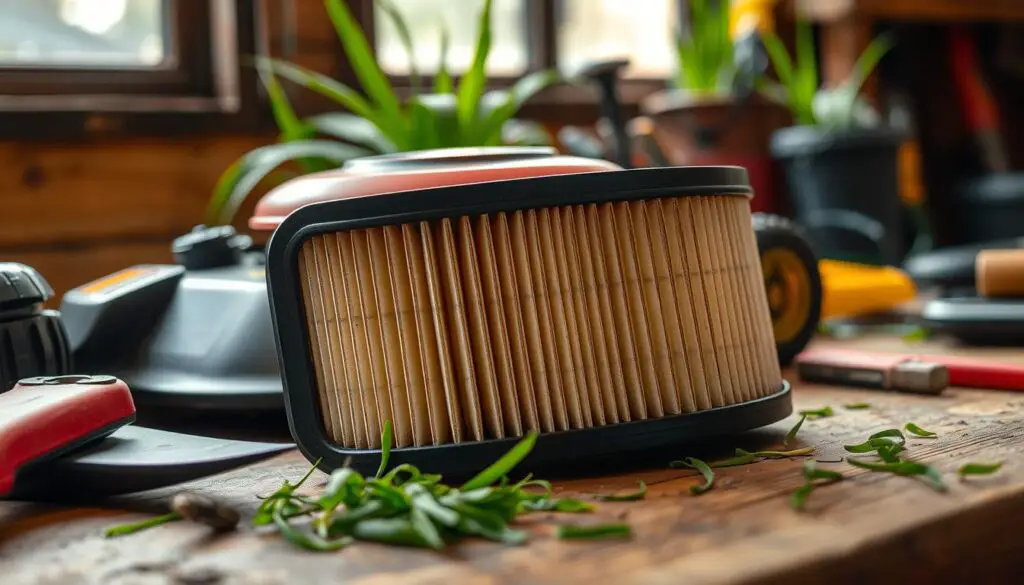How to Properly Maintain Your Lawn Mower

Did you know a well-maintained lawn mower can last 10-15 years? That’s a long time, showing how key lawn mower maintenance is. As a homeowner or landscaper, regular upkeep can save you money and keep your mower working great for years.
In this guide, I’ll share 10 vital maintenance tips. These will help your lawn mower run smoothly and last longer. You’ll learn how to stabilize fuel, replace spark plugs, and sharpen blades. These steps will keep your mower in top shape all mowing season.
Key Takeaways
- Regular lawn mower maintenance is key to extending its life.
- Good maintenance saves you money and keeps your mower efficient.
- Always follow the manufacturer’s care instructions for your mower.
- Seasonal tune-ups at the start or end of mowing season are crucial.
- Sticking to a maintenance routine all year will make your mower last longer.
Stabilize the Fuel
Keeping your lawn mower in good shape starts with stabilizing the fuel. Fuel left in a mower for too long can clog carburetors and harm the engine. Regular use during the mowing season helps avoid these problems. But, if your mower sits idle for over 30 days, it’s time to add a fuel stabilizer.
Prevent Carburetor Clogs and Engine Damage
Fuel stabilizers, costing under $10, are essential for off-season mower storage. They ensure a smooth start and trouble-free operation when mowing resumes in spring. Experts say fuel can start to break down in just 30 days if left in a mower or gas can.
Since mowers often sit idle for 4 months in winter, adding a fuel stabilizer to fresh gas in early November is wise. This protects the fuel system and prevents issues when you start your mower again. Some users run their mowers for 5-7 minutes every 30 days to keep parts lubricated and ensure a reliable start in spring.
Electric mowers don’t need fuel stabilization, making off-season prep easier.
“Fuel stabilizers are a must-have when it comes to mower storage preparation. They help protect your investment and ensure a hassle-free start to the next mowing season.”
Change the Engine Oil Regularly
Keeping your lawn mower’s engine healthy is key, and changing the oil is a big part of that. The engine’s moving parts create heat, which can damage the oil. So, it’s vital to change the oil as often as the owner’s manual suggests.
For a new mower, change the oil after the first use or after about five hours. If you have an older push mower, change the oil once a season or every 50 hours. Riding mowers need oil changed at least once a season or every 100 hours.
When you change the oil, fill it up to the mark on the dipstick. Using premium oil can make your engine run better and save fuel. Oil for lawn mowers costs between $4 to $12 per quart. The whole oil change process should take about 30 minutes. Most push mowers need about 20 ounces (5/8 quart) of oil.
By following the owner’s manual recommendations for lawn mower oil change intervals and using high-quality engine lubrication, you’ll make your mower’s engine last longer. This ensures it runs smoothly and efficiently.

Maintain a Reliable Battery
Keeping your lawn mower’s battery in good shape is key for its performance. The lawn mower battery powers lights, sensors, and the starter. Knowing its voltage needs and charging requirements is vital.
A riding mower battery lasts three to five years. Proper battery charging and electrical system maintenance can make it last longer. If your mower sits for four weeks, the battery might still start it up. But, if it’s over five years old or won’t charge, it’s time for a new one.
It’s important to check the battery during the off-season. This prevents it from draining completely and not starting in spring. Regular checks on voltage requirements and battery charging keep your mower efficient.
| Metric | Value |
|---|---|
| Average Battery Life | 3-5 years |
| Charge Retention | Up to 4 weeks |
| Replacement Recommendation | Older than 5 years or no longer holding charge |
By keeping your lawn mower battery in top shape, you ensure your mower works right. Regular checks and care prevent breakdowns and safety issues. This keeps your mower running well all season.
Keep the Deck Clean
Keeping your lawn mower deck clean is key for its health and performance. Not cleaning it can cause rust, lower mowing quality, and harm the engine. Regular cleaning helps your mower last longer and keeps your lawn looking great.
Prevent Rust and Buildup
It’s vital to clear the area under the mower deck of grass clippings. Rinsing the mower with water is a good start, but make sure to dry the deck afterward. For tough buildup, use a blower or a scrubber to clean hard spots.
Some experts suggest using a silicone spray on the deck. This creates a barrier against future buildup.
| Cleaning Product | Popularity Among Lawn Care Pros |
|---|---|
| Purple Power | 41% |
| Simple Green | 31% |
| Ballard’s Mower Magic | 7% |
| Pressure Washer Alone | 20% |
By keeping your mower deck clean, you prevent rust and improve mowing. Always check your mower’s manual for cleaning tips. Use a reliable deck cleaner or a pressure washer to keep your mower in great shape.
Replace Spark Plugs Annually
As a lawn mower owner, keeping up with maintenance is key. Spark plugs are crucial for your mower’s engine. They help it start and run well.
The Operator’s Manual says to check and replace spark plugs every year. If your mower won’t start, check the spark plugs. When cleaning them, avoid harsh abrasives to prevent damage.
Spark plugs should be tightened to 15 ft. lbs. for best performance. A Briggs & Stratton® tune-up kit is great for maintenance. It includes spark plugs and other important parts.
Always check the manuals before servicing to avoid accidents. Replacing spark plugs yearly keeps your mower’s engine healthy. This ensures your lawn looks great all season.

lawn mower maintenance: Sharpen and Balance the Blades
Keeping your lawn mower in top shape is key to a beautiful lawn. Sharpening and balancing the blades are crucial. Sharp blades cut grass smoothly and keep your yard looking great.
Sharpen your lawn mower blades twice a year or after 25 hours of use. Sharp blades make clean cuts and prevent damage to your lawn. Aim for a sharp edge, like a butter knife, but not too sharp.
It’s also important to balance the blades. An unbalanced blade can damage your mower and leave your lawn uneven. Use nails or a balancing tool to rebalance the blades after sharpening.
Having extra blades on hand is a good idea. They cost about $30, depending on your mower size. This way, you can switch blades and make each one last longer.
Always follow the manufacturer’s advice for lawn mower blade sharpening, blade balancing, and blade replacement. This will keep your mower running well and your lawn looking great all season.
| Maintenance Task | Recommended Frequency |
|---|---|
| Sharpen Blades | Every 20-25 hours of use |
| Balance Blades | After each sharpening |
| Blade Replacement | As needed, typically every 1-2 seasons |
“Routine maintenance like sharpening blades, changing engine oil, and cleaning air filters can improve a lawn mower’s performance and extend its lifespan.”
Check and Clean the Air Filter
Keeping your lawn mower’s air filter clean is key for its performance and longevity. A clean air filter lets the engine get the air it needs for good combustion. As you mow, dust and clippings can block the air flow.
Ensure Proper Air-Fuel Ratio
It’s important to clean or replace the air filter regularly. You can wash foam filters with mild soap or swap out paper filters when they’re dirty. Foam filters last longer and need less care, while paper filters filter better but need more frequent changes.
Change the air filter every 25 hours of use or once a season. In very dusty areas, you might need to clean and replace it more often. This ensures your engine gets the right mix of air and fuel for best performance.
| Filter Type | Cleaning Frequency | Replacement Frequency |
|---|---|---|
| Foam | Every 25 hours | Once per season or 300 hours |
| Paper | Every 25 hours | Once per season or 300 hours |
Keeping your lawn mower’s air filter clean is simple but crucial. It helps the engine run better, lasts longer, and keeps your lawn in top shape. For more lawn care tips, check out online resources.

Replace the Fuel Filter
Keeping your lawn mower’s fuel system in good shape is key for its performance. The fuel filter is a crucial part of this system. It makes sure the fuel is clean and free from contaminants, preventing engine damage.
The fuel filter catches dirt and other particles that might get into the fuel tank. As these particles build up, the filter can get clogged. This can stop fuel from flowing properly, making the engine run poorly or even stop working. It’s important to replace the fuel filter regularly to keep your mower running well.
- Fuel filter replacement prevents foreign particles from clogging the engine’s fuel system.
- Dirty fuel filters can cause engines to run too lean, resulting in diminished performance and uneven operation.
- The fuel filter can be located inside the fuel tank or in the fuel line between the tank and the fuel pump. Some tanks have internal, non-serviceable filters.
- It is crucial to wear safety eyewear during filter inspection or replacement to protect against fuel vapors.
- Proper maintenance requires draining the tank before removing the filter for inspection or replacement.
- Filters with debris should be replaced with a new one.
- Some filters have a directional flow arrow that must be installed correctly for proper operation.
- Regular inspection and replacement of fuel lines are advised to prevent leaks.
- It’s recommended to consult the engine and equipment manuals before performing any maintenance procedures.
By keeping up with your lawn mower’s fuel filter replacement, you ensure its fuel system maintenance and fuel cleanliness are top-notch. Remember to also check the filter location and the primer bulb servicing. This will help your mower run at its best.

Check Tire Pressure
Keeping your lawn mower’s tire pressure right is key for even grass cutting and a smooth ride. If the pressure is off, the mower deck might cut the grass unevenly. This can make your lawn look bad.
The right tire pressure for lawn mowers is between 10 and 14 psi. Always check the pressure when the tires are cold. This is because warm tires can have different pressure levels. Proper pressure makes your lawn look great and your mower work better.
Low tire pressure makes the engine and transmission work harder. This means your mower uses more fuel and wears out faster. On the other hand, too much pressure can make the ride bumpy and harm your lawn.
| Tire Pressure Recommendations | Pressure (PSI) |
|---|---|
| Front Tires | 14 PSI |
| Rear Tires | 10 PSI |
Check your lawn mower tires often for damage like cracks or cuts. Replacing worn-out tires keeps your mower safe and comfortable. Properly inflated and well-maintained tires help your lawn look neat and your mower last longer.
Proper tire care for your lawn mower greatly improves your lawn’s look and your mower’s performance. By following these easy steps, you can keep your lawn perfect and your mower in top shape.
Service the Belts
Keeping your lawn mower’s belts in good shape is key for top performance and long life. Regular checks and timely replacements are crucial. This ensures a smooth cut, even on hills. By monitoring your mower’s belts, you avoid expensive repairs and keep your lawn looking great.
When checking the belts, watch for cracks and wear. Damaged belts can weaken power transmission, hurting hill cutting and overall results. If you see cracks or excessive wear, replace them quickly to get your mower back to full power.
For the best performance, replace belts every year or sooner if they’re badly worn. This keeps your mower running smoothly and extends the life of other important parts like pulleys and blades.
| Maintenance Task | Recommended Torque |
|---|---|
| Tighten crankshaft pulley bolt | 37.5 – 50 foot pounds (51-68 Newton Meters) |
| Secure transaxle pulley to input shaft | 10-15 foot pounds (13.6-20.3 Newton meters) |
Proactive lawn mower belt maintenance is essential. It ensures your mower works at its best, tackling any lawn task with ease.
Conclusion
By following the steps in this article and my lawn mower’s manual, I’ve kept my equipment running for years. Regular lawn mower maintenance like oil changes and blade sharpening has helped. If you’re not sure about some tasks, getting professional service is a good idea.
For more tips on lawn mower care and a healthy lawn, check out the Alabama Extension Urban Lawn and Garden page. No matter your mower type, a regular maintenance routine is crucial. It helps your mower last longer and mows your lawn efficiently all season.
Proper care for my lawn mower has given me a beautiful yard without the hassle of repairs. With some effort and the right tools, you can do the same. Keep your mower in top shape for years of use.
FAQ
What is the importance of lawn mower maintenance?
How can I prevent fuel-related issues with my lawn mower?
How often should I change the oil in my lawn mower?
Why is maintaining a reliable battery important for a lawn mower?
How should I clean the mower deck?
When should I replace the spark plugs on my lawn mower?
How do I maintain my lawn mower blades?
Why is it important to clean the air filter on my lawn mower?
How often should I replace the fuel filter on my lawn mower?
Why is it important to maintain proper tire pressure on my lawn mower?
How do I maintain the belts on my lawn mower?
Source Links
- https://www.aces.edu/blog/topics/lawn-garden-urban/the-10-steps-of-lawn-mower-maintenance/
- https://www.lawndoctor.com/lawn-mower-maintenance/
- https://www.homedepot.com/c/ah/lawn-mower-maintenance/9ba683603be9fa5395fab90384c7981
- https://www.milorganite.com/blog/Lawn/preparing-your-lawn-mower-winter
- https://www.bogleheads.org/forum/viewtopic.php?t=284853
- https://www.familyhandyman.com/article/how-to-change-oil-in-lawn-mower/
- https://www.searshomeservices.com/blog/riding-mower-maintenance-8-tips-to-make-your-mower-last
- https://www.cubcadet.com/en_US/product-information/knowledge-riding-mower-maintenance-schedule-and-tips.html
- https://www.stryten.com/tips-for-lawn-and-garden-battery-maintenance/
- https://egopowerplus.eu/node/3127
- https://www.greenmarkequipment.com/news/current news/how-to-maintain-and-clean-your-lawn-mower-deck/
- https://www.yourgreenpal.com/blog/what-is-the-best-way-to-clean-a-lawn-mower-deck-the-right-way
- https://www.briggsandstratton.com/na/en_us/support/faqs/browse/servicing-the-spark-plug.html
- https://www.trigreenequipment.com/new-equipment/lawn-care-equipment/lawn-mower-tune-up-maintenance-guide/
- https://www.homedepot.com/c/ah/how-to-sharpen-lawn-mower-blades/9ba683603be9fa5395fab904bc45dce
- https://lawnlove.com/blog/how-to-sharpen-lawn-mower-blades/
- https://www.lowes.com/n/how-to/sharpen-lawn-mower-blades
- https://www.lawnstarter.com/blog/lawn-care-2/how-to-clean-change-lawn-mower-air-filter/
- https://www.familyhandyman.com/article/lawn-mower-air-filter/
- https://www.thespruce.com/lawn-mower-maintenance-cleaning-air-filter-2153063
- https://www.briggsandstratton.com/na/en_us/support/faqs/browse/fuel-filter-replacement.html
- https://www.familyhandyman.com/article/lawn-mower-fuel-filter/
- https://www.manmadediy.com/change-oil-spark-plug-fuel-filter-lawn-mower/
- https://antegowheels.com/blogs/news/how-to-check-your-lawnmower-tires-for-signs-of-wear
- https://www.lawnstuff.com/blogs/lawn-mowers/the-ultimate-guide-to-lawn-mower-tires-pressure-types-maintenance-and-more
- https://www.mtdparts.com/en_US/knowledge-how-to-change-riding-lawn-mower-drive-belt-repairs.html?srsltid=AfmBOoptXEzXD7TgP8BeAMozsllQIdERino4t1GrF4hlCCN6yYEi7-Ig
- https://www.familyhandyman.com/article/riding-lawn-mower-repair/
- https://www.sacandagaoutdoor.com/blogs/news/why-lawn-mower-maintenance-is-absolutely-essential?srsltid=AfmBOoo7CjPYfl2Q-qk8m9EyTknPpDG12NirZQYIf_YNLuoSlV9VZpbp
- https://singleops.com/lawn-mower-maintenance-best-practices-for-extending-lifespan/

